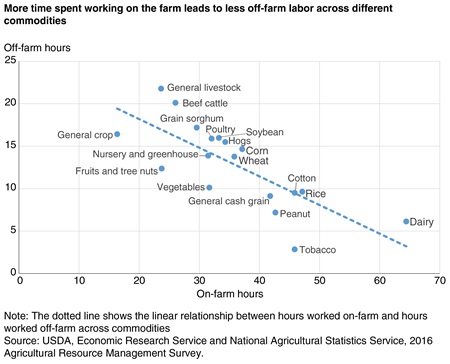Farm Households Divide Their Time Between On-Farm and Off-Farm Labor

Farm households allocate their working time between on-farm and off-farm labor. Survey data show that the more time allotted to the farm operation, the less time available for off-farm employment. For example, households operating larger farms devote more of their time toward the farm operation than households with smaller farms, and they also derive more income from the operation. In 2016, the principal operators of farms with over $350,000 in annual gross cash farm income (GCFI) worked an average of 54 hours per week on their operation, and their households earned an average of $243,000 in farm-related income after expenses. Conversely, operators of farms with annual GCFI under $350,000 worked 24 hours per week on their farm, and their households earned an average of $3,000 in farm-related income after expenses.
The commodity type produced by a farm can also have implications for the structure and income received by farm households. Clear differences in labor allocation emerge as a result. Many farm operations require primarily part-time or seasonal work, which can allow members of the operator’s household to work off-farm with little interruption to the farming operation. Across all farms by commodity type, in 2016, average on-farm hours worked by the principal operator ranged from 16 hours per week for general crop farms to 64 hours per week for dairy farms. Principal operators of cotton, peanut, and rice farms worked an average of over 40 hours a week on-farm—while operators of general livestock, beef cattle, and fruit and nut farms worked less than 30 hours per week on-farm.
In addition to farm size and commodity type, off-farm work by principal operators varied by operator age. Younger farmers (under age 35) worked 31 hours a week on-farm on average while devoting another 31 hours per week to other work pursuits. By comparison, older farmers (age 65 or older) spent an average of 25 hours per week working on their farm and just 9 hours working off-farm.
Spending time working on-farm limits the time available not only for off-farm employment but also for housework, families, or leisure activities (including sleep). Accordingly, the amounts of time spent working on- and off-farm are negatively correlated across all commodity types (although there is substantial variation across different commodities). For example, dairy farmers tend to have the most rigid farm schedules, and so they work only 6 hours per week off-farm on average. By comparison, beef cattle farmers tend to have highly flexible schedules and so spend an average of 20 hours per week in off-farm employment.
Economic Returns to Farming for U.S. Farm Households, by Daniel Prager, Sarah Tulman, and Ron Durst, ERS, August 2018
Farm Household Well-being, by Katherine Lim, USDA, Economic Research Service, February 2024
Farm Household Income and Characteristics, by Katherine Lim and Katherine Lacy, USDA, Economic Research Service, February 2024
Farm Structure and Organization, by Daniel Bonin, USDA, Economic Research Service, January 2024
Webinar: Farm Income and Financial Forecasts, August 2017 Update, by Carrie Litkowski, USDA, Economic Research Service, February 2024


